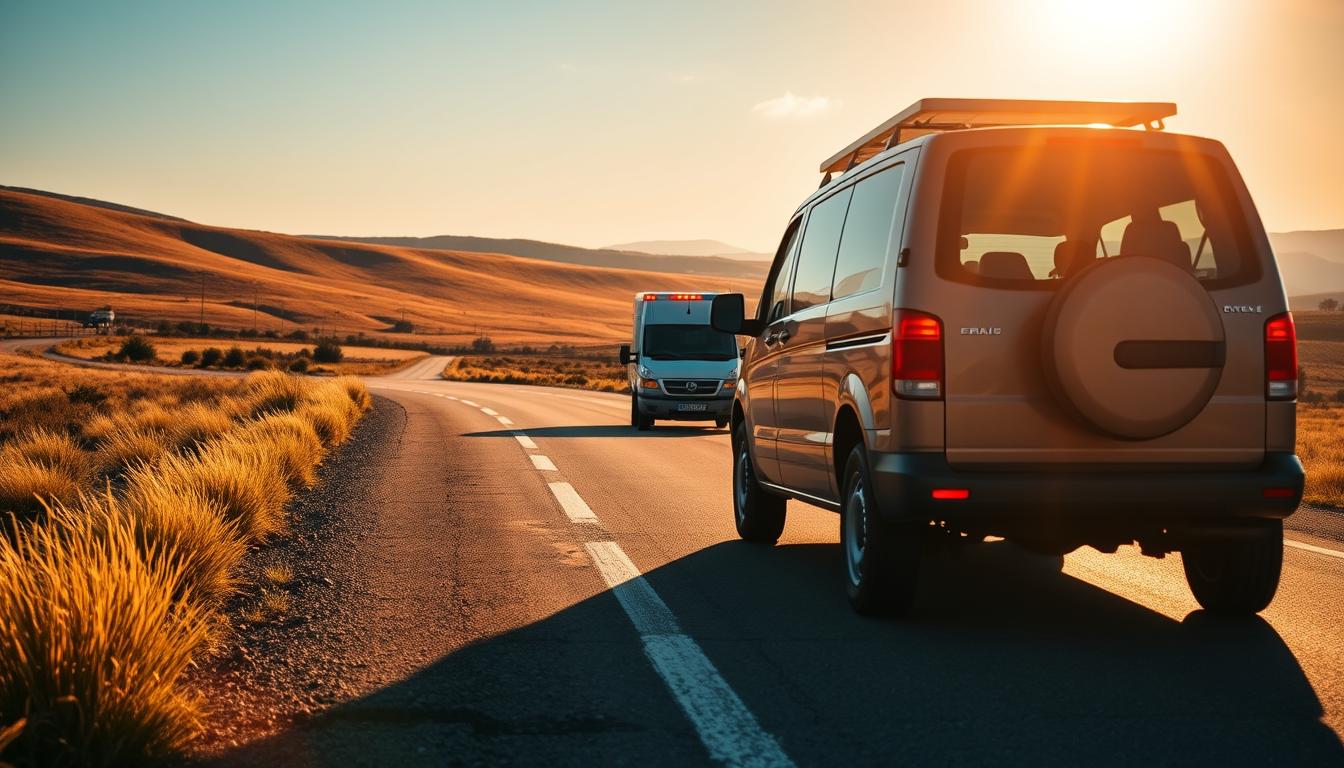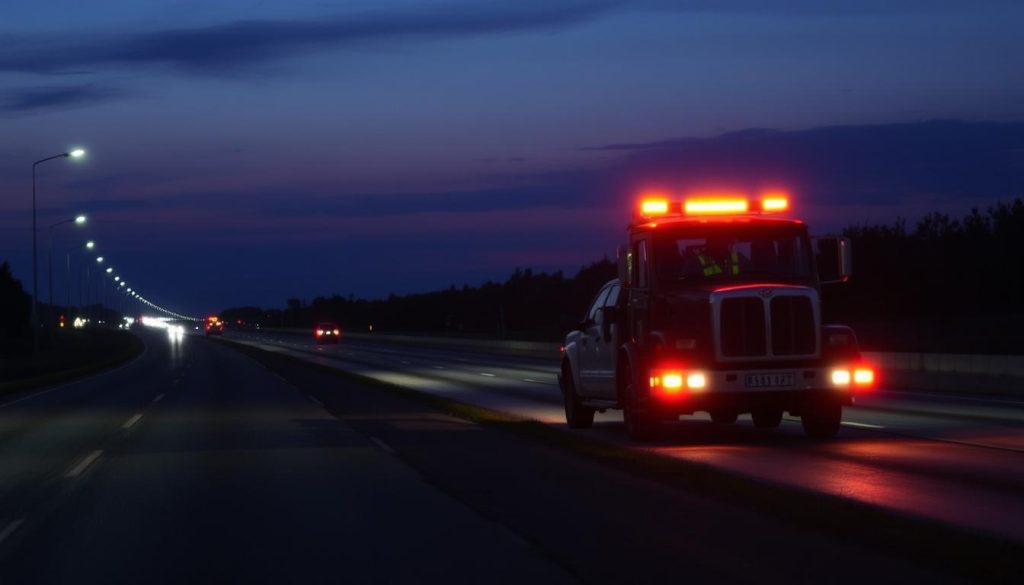
Imagine your car sputters to a stop during rush hour. Your phone battery’s low, and rain pours outside. What now? Since 1915, services like professional roadside assistance have transformed these panic-filled moments into manageable hiccups. Even modern vehicles face unexpected issues – think flat tires, dead batteries, or that mysterious warning light blinking on your dashboard.
Today’s drivers enjoy 24/7 support that arrives faster than pizza delivery. Mechanics don’t just jump-start batteries – they’ll bring gas if you’re stranded, change tires on dark highways, or even unlock doors when keys get left inside. Ever tried flagging down help at midnight? It’s safer – and warmer – to wait in your car while experts handle the dirty work.
These services cost less than most streaming subscriptions. For about $10/month, you avoid tow truck fees that can hit $300+. Parents especially appreciate the safety net – would you want your teen waiting alone on a deserted road? Roadside help turns “worst-day-ever” stories into “remember-that-time” adventures.
Back in 1915, drivers faced breakdowns alone on dirt roads. Cars weren’t just transportation – they were unpredictable machines needing constant fixes. That’s when organized help began changing how motorists handle trouble.
Roadside assistance means expert help comes to your stranded vehicle. Whether you’re stuck with a dead battery or locked out, professionals handle it. Think of it like having a mechanic in your phone – one tap connects you to solutions.
AAA started with mechanics biking to broken Model Ts in St. Louis. No tow trucks? They fixed cars using tools carried in saddlebags. Today’s services use GPS to dispatch help within minutes. What took hours in 1915 now takes 30 minutes – even at 3 AM.
Modern plans cover everything from fuel delivery to winching cars out of ditches. Unlike early programs limited to AAA members, today’s options work for motorists using any auto brand. Breakdowns still happen, but waiting alone? That’s history.
Have you ever wondered what happens when your car gives up on a lonely highway? Modern help arrives faster than you can say “flat tire.” Let’s explore the real-world solutions that turn panic into relief.
When your car becomes a metal paperweight, towing services send specialized trucks. These aren’t your grandpa’s tow trucks – they’re equipped with wheel lifts and flatbeds to protect your vehicle. Stuck in a snowbank? Winching systems can pull you free without damaging the undercarriage.
Three common nightmares get quick fixes:
Ever left your lights on during dinner? You’re not alone – this service gets used 1.2 million times daily nationwide.
That sickening “clunk” of keys locking inside happens to 4 million Americans yearly. Modern tools like air wedges and long-reach tools open doors faster than coat hangers. For complex emergency cases, mobile locksmiths can cut new keys on-site.
From empty gas tanks to frozen door locks, these services turn “I’m stuck” into “I’m sorted” within minutes. What would’ve been a multi-hour ordeal now gets solved before your phone battery dies.
Did you know paying for a single tow often costs more than your entire insurance premium? Picture this: your car stalls on an empty stretch of highway. Without coverage, you’re Googling tow companies while watching your phone battery drain. Now imagine tapping an app instead – help arrives before panic sets in.

Modern roadside assistance acts like a superhero for your vehicle. Most providers guarantee a 30-minute response – faster than ordering delivery. Compare that to waiting hours for a stranger’s tow truck. Ever tried changing a tire in rush-hour traffic? Professionals handle it safely while you stay protected inside your car.
Let’s talk numbers. A typical tow runs $100-$300 out-of-pocket. Annual assistance plans?
That’s less than most drivers spend on coffee monthly. Many services include real-time tracking too. Watch the rescue vehicle approach on your phone map – no more guessing when help will arrive.
Why risk draining your wallet and patience? Reliable roadside support turns expensive emergencies into manageable bumps in the road. One flat tire or dead battery makes the cost worthwhile – and that’s before counting the priceless peace of mind.
What’s better than having a guardian angel for your vehicle? Modern protection plans turn breakdowns from disasters into minor delays. Picture this: your car coughs to a stop during a cross-country trip. Instead of stress, you feel relief – help is already rolling your way.
Every call is different, but our approach is always the same: fast, friendly, and effective.
Locked out at a rest stop? Battery dead in a parking garage? Trained experts handle these situations daily. One call brings specialists equipped for everything from flat tire repair to emergency fuel delivery. You stay safe inside your vehicle while they work.
That midnight tow could drain your savings. Most drivers pay $120-$450 per emergency without coverage. Annual protection plans cost less than dinner for two – often under $100. Insurance companies now bundle these services, making them easier to afford than ever.
Consider the hidden costs of going without: rental cars, missed appointments, risky DIY fixes. Roadside support eliminates these headaches. Parents especially appreciate knowing their teen drivers won’t face dangerous situations alone.
From dead batteries to snowbound tires, modern coverage acts like an invisible safety net. It’s not just about fixing cars – it’s about protecting what matters most. Why gamble with your security when peace of mind comes so affordably?
Ever wonder what else your coverage includes besides towing? Today’s options stretch far beyond basic car help. Providers now bundle solutions that protect your entire lifestyle – often through partnerships you already use.
Your weekend adventures need protection too. Many plans let you add motorcycles, RVs, or boats for less than a latte per month. Some even cover bicycles – perfect for cyclists stranded miles from home.
Family coverage shines here. Add spouses, teens, or college kids under one policy. No more worrying if your newly licensed driver forgets their jumper cables.
Check your existing services – you might already have help. Major insurance companies like State Farm and Geico offer add-ons. Bought a car recently? Dealerships often include free service for 3-5 years.
Surprise sources provide backup too:
Why juggle multiple plans when your credit card or phone bill already has you covered? These smart partnerships turn “emergency expenses” into “already handled” moments.
How do you pick the perfect safety net for your vehicle when options overwhelm you? Start by mapping your driving life. Do quick grocery runs make up most trips, or are you regularly cruising highways where help could be hours away? Your answers shape which plan fits best.
Towing distance separates basic plans from premium ones. One company might cover 5 miles – barely enough to reach the nearest garage. Others offer 100+ miles, crucial for rural breakdowns. Always ask: “What’s the max they’ll tow?”
Watch for sneaky fees. Some plans charge extra for:
Your insurance policy might already include roadside help – check before buying new coverage. Adding it often costs less than standalone plans. Prefer flexibility? Pay-per-use options let you request help only when needed, like during cross-country moves.
Families should verify if plans protect teen drivers or borrowed cars. One mom discovered her assistance plan didn’t cover her college kid’s campus breakdown – a $300 lesson. Now she uses a company that covers all household vehicles.
Response times matter most during emergencies. Urban drivers might get help in 20 minutes, while rural areas could wait 90+. Test providers: “What’s your average tow truck arrival time near Route 66?” Your safety depends on their honesty.
What’s your plan when your car suddenly stops on a rainy highway? Modern drivers face fewer worries thanks to roadside assistance plans. Whether dealing with dead batteries or locking keys inside, these roadside assistance services turn panic into quick solutions.
Your insurance might already cover jump-starts or fuel delivery – check your policy today. Parents sleep better knowing teens won’t face dangerous emergency situations alone. Even experienced motorists appreciate having expert help one phone call away.
Think about last year’s close calls. Could reliable support have saved time, money, or stress? For less than the cost of a tank of gas, you protect every vehicle in your household. Why gamble with roadside surprises when peace of mind rides shotgun?
Most plans include towing, battery jump-starts, flat tire changes, fuel delivery, and lockout services. Some providers like AAA or Good Sam also offer extras like trip interruption reimbursement or RV coverage.
Insurance covers accidents and repairs, while roadside assistance focuses on immediate fixes for breakdowns. Think of it as a safety net for unexpected hiccups like dead batteries or empty gas tanks.
Yes. Many plans cover 3-10 miles for free, with longer distances costing extra. Companies like Progressive often include 15+ miles, so always check your plan’s details. This is especially important if your car breaks down on the road.
Absolutely! Most providers send locksmiths or use tools to unlock doors without damage. For example, Allstate’s Motor Club handles over 4 million lockouts yearly, making it a valuable roadside assistance service.
Many do. Providers like Good Sam specialize in RV coverage, while others like Harley-Davidson offer motorcycle-specific plans. Always confirm vehicle eligibility before signing up for membership.
24/7 support means help arrives anytime. Services like GEICO’s Emergency Roadside Assistance will jump-start your battery even during late hours—no extra charge, providing peace of mind compared to standard insurance.
Wait times vary, but top companies like AAA aim for under 45 minutes in urban areas. Rural spots might take longer, but dispatchers prioritize emergencies, ensuring you receive the roadside assistance you need.
Usually, yes—if you’re present during the breakdown. Plans from State Farm or USAA often cover any vehicle you’re driving or riding in, making it a flexible service.
Sometimes. Basic plans might charge fees if your car’s stuck in mud or snow. Providers like Better World Club include limited winching in premium tiers, enhancing their roadside assistance offerings.
Yes, but you’ll pay for the gas. Companies like Nationwide bring up to 2-3 gallons to get you to the nearest station, often with no delivery fee, ensuring you stay on the road without stress.
Lorem ipsum dolor sit amet, consectetur adipiscing elit. Ut elit tellus, luctus nec ullamcorper mattis.